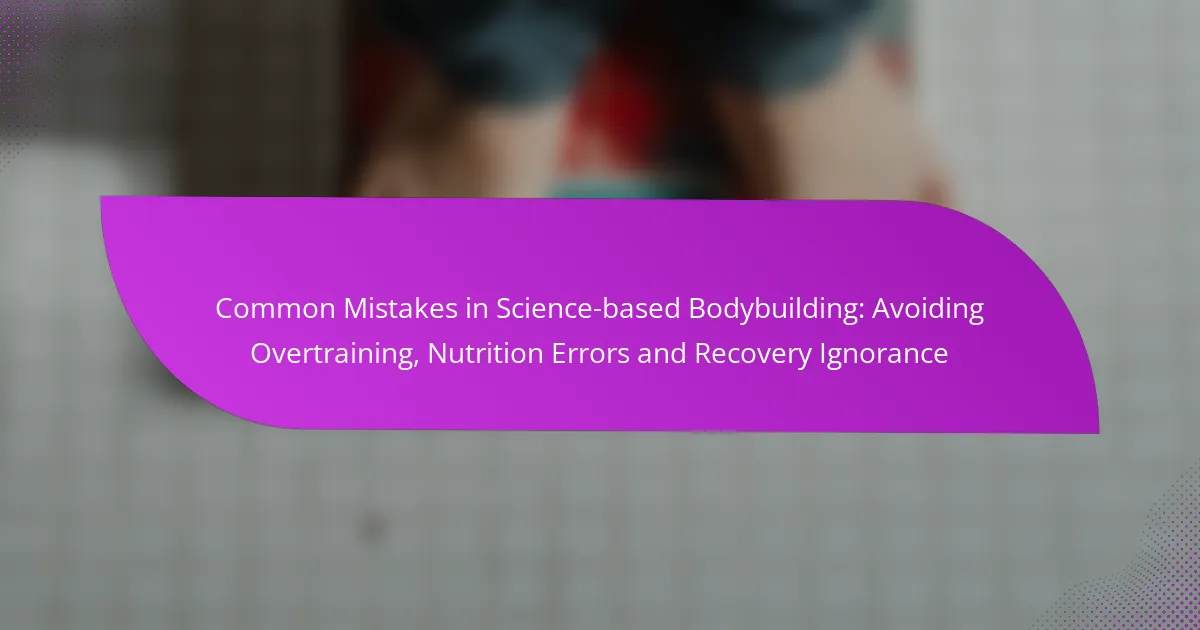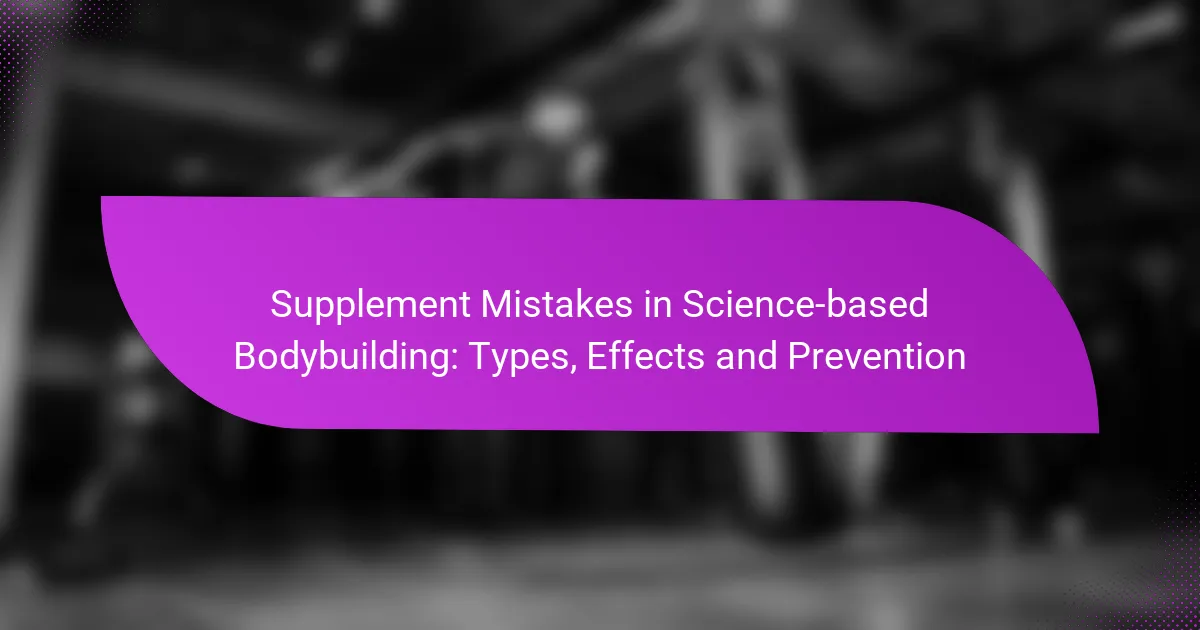In the pursuit of bodybuilding excellence, avoiding common pitfalls is vital for success. Overtraining, nutrition errors, and neglecting recovery can significantly hinder progress and increase the risk of injury. By understanding and addressing these issues, bodybuilders can optimize their training and achieve their goals more effectively.

How to Avoid Overtraining in Bodybuilding?
To avoid overtraining in bodybuilding, it’s crucial to balance your workout intensity with adequate recovery. Overtraining can lead to fatigue, decreased performance, and increased injury risk, making it essential to implement effective training strategies.
Implementing a structured training schedule
A structured training schedule helps prevent overtraining by ensuring that workouts are balanced and varied. Aim for a routine that includes different muscle groups, allowing each group sufficient recovery time. For example, a split routine can be effective, where you train upper body one day and lower body the next, ensuring each area gets rest.
Consider incorporating rest days into your weekly schedule. A common approach is to train for three to five days a week, depending on your experience level, while taking at least one or two full rest days to promote recovery.
Recognizing signs of overtraining
Being aware of the signs of overtraining is vital for maintaining your health and performance. Common indicators include persistent fatigue, decreased strength, irritability, and sleep disturbances. If you notice these symptoms, it may be time to reassess your training intensity and volume.
Keep a training log to track your workouts and how you feel. This can help you identify patterns that may indicate overtraining, allowing you to make timely adjustments to your regimen.
Incorporating deload weeks
Deload weeks are periods of reduced training intensity or volume, typically lasting one week, that help your body recover. Incorporating a deload week every four to six weeks can prevent overtraining and promote long-term progress. During this time, reduce the weight you lift by 40-60% or decrease the number of sets and reps.
Use deload weeks as an opportunity to focus on technique or engage in lighter activities like yoga or swimming. This approach can refresh your mind and body, preparing you for the next training cycle.
Utilizing periodization techniques
Periodization involves varying your training program over time to optimize performance and recovery. By cycling through phases of different intensity and volume, you can prevent plateaus and reduce the risk of overtraining. Common models include linear, undulating, and block periodization.
For example, in a linear periodization model, you might start with higher reps and lower weights, gradually increasing the weight while decreasing the reps over several weeks. This structured approach allows for both progression and recovery, keeping your training effective and sustainable.

What Nutrition Errors Should Bodybuilders Avoid?
Bodybuilders must be vigilant about nutrition errors that can hinder their progress. Common mistakes include failing to balance macronutrients, neglecting essential vitamins and minerals, over-relying on supplements, and ignoring hydration needs.
Failing to meet macronutrient ratios
Macronutrient ratios are crucial for muscle growth and recovery. A typical guideline suggests a distribution of approximately 40% carbohydrates, 30% protein, and 30% fats, but individual needs may vary based on activity level and body composition goals.
To avoid falling short, track your intake using apps or food diaries. Regularly adjust your ratios based on your training intensity and results to ensure optimal performance and muscle gain.
Neglecting micronutrient intake
Micronutrients, including vitamins and minerals, play vital roles in energy production and muscle function. Bodybuilders often overlook these nutrients, leading to deficiencies that can impair recovery and performance.
Incorporate a variety of fruits, vegetables, and whole foods into your diet to cover your micronutrient bases. Consider a multivitamin if your diet lacks diversity, but prioritize whole foods for the best absorption and benefits.
Over-relying on supplements
While supplements can support bodybuilding goals, relying too heavily on them can lead to imbalanced nutrition. Whole foods should form the foundation of your diet, with supplements used to fill specific gaps.
Focus on obtaining most of your nutrients from food sources. Use supplements like protein powders or creatine strategically, ensuring they complement a well-rounded diet rather than replace it.
Ignoring hydration needs
Hydration is often underestimated but is essential for optimal performance and recovery. Dehydration can lead to fatigue, decreased strength, and impaired recovery, affecting overall progress.
Aim to drink at least 2-3 liters of water daily, adjusting for sweat loss during workouts. Monitor your hydration status by checking urine color; pale yellow indicates adequate hydration, while darker shades suggest a need for more fluids.

How to Optimize Recovery in Bodybuilding?
Optimizing recovery in bodybuilding is essential for muscle growth and overall performance. Effective recovery strategies can enhance your training results and prevent injuries.
Prioritizing sleep quality
Sleep quality is a cornerstone of recovery in bodybuilding. Aim for 7-9 hours of uninterrupted sleep each night to allow your body to repair and grow muscle tissue. Consider creating a sleep-friendly environment by minimizing light and noise and maintaining a consistent sleep schedule.
To enhance sleep quality, avoid caffeine and heavy meals close to bedtime. Techniques such as meditation or reading can help you unwind and prepare for restful sleep.
Incorporating active recovery days
Active recovery days involve low-intensity workouts that promote blood flow and aid muscle recovery without adding significant stress. Activities like walking, cycling, or yoga can be beneficial. Aim for 1-2 active recovery days per week, depending on your training intensity.
These days help reduce muscle soreness and stiffness while maintaining your fitness level. Listen to your body and adjust the intensity based on how you feel.
Utilizing recovery tools like foam rollers
Foam rollers and other recovery tools can significantly enhance muscle recovery by improving blood circulation and reducing muscle tightness. Incorporate foam rolling sessions for 10-15 minutes after workouts to target sore areas.
Other tools like massage balls or percussion massagers can also be effective. Use them regularly to maintain muscle flexibility and prevent injuries.
Understanding the importance of rest days
Rest days are crucial for muscle recovery and growth. They allow your body to repair micro-tears in muscle fibers caused by intense workouts. Schedule at least one full rest day per week to give your body time to recuperate.
During rest days, focus on hydration and nutrition to support recovery. Avoid strenuous activities and listen to your body’s signals to determine when additional rest may be necessary.

What Are the Prerequisites for Effective Bodybuilding?
Effective bodybuilding requires a clear understanding of fitness goals, an honest assessment of your current fitness level, and a well-structured workout plan. These prerequisites help ensure that your training is both efficient and sustainable, minimizing the risk of injury and maximizing results.
Establishing clear fitness goals
Setting specific, measurable, achievable, relevant, and time-bound (SMART) goals is crucial for effective bodybuilding. For example, instead of saying “I want to get stronger,” specify “I want to increase my bench press by 10 kg in three months.” This clarity helps maintain focus and motivation.
Consider both short-term and long-term goals. Short-term goals can include increasing weights or improving form, while long-term goals might involve achieving a certain physique or competing in a bodybuilding event. Regularly revisiting and adjusting these goals is essential as you progress.
Assessing current fitness level
Understanding your current fitness level is vital to tailor your bodybuilding program effectively. This assessment can include evaluating your strength, endurance, flexibility, and body composition. Simple tests like push-ups, squats, or a timed run can provide insight into your capabilities.
Consider consulting with a fitness professional for a more comprehensive evaluation. They can help identify strengths and weaknesses, which can inform your workout plan and help avoid overtraining or injury. Regular assessments every few months can track progress and adjust goals accordingly.
Creating a balanced workout plan
A balanced workout plan should incorporate resistance training, cardiovascular exercise, and flexibility work. Aim for at least three to four days of strength training per week, focusing on different muscle groups to allow for recovery. Include cardio sessions to enhance endurance and support overall health.
Ensure your plan includes rest days to prevent overtraining, which can hinder progress and lead to injuries. A common approach is to follow a split routine, targeting specific muscle groups on different days. For instance, you might work on legs one day, chest and triceps another, and back and biceps on a third day.

What Advanced Techniques Can Enhance Bodybuilding Results?
Advanced techniques can significantly boost bodybuilding results by optimizing training, nutrition, and recovery strategies. These methods focus on maximizing muscle growth and minimizing injury risk through careful planning and execution.
BODY REQUIREMENTS
Understanding body requirements is crucial for effective bodybuilding. This includes knowing your caloric needs, macronutrient ratios, and hydration levels. Generally, a balanced diet with adequate protein, carbohydrates, and fats supports muscle growth and recovery.
For most bodybuilders, protein intake should be around 1.6 to 2.2 grams per kilogram of body weight daily. Carbohydrates are essential for energy, particularly around workouts, while healthy fats contribute to overall health. Keeping track of these requirements can help maintain optimal performance.
Regularly assess your body composition and adjust your intake based on your goals. For example, if you’re aiming to gain muscle, consider increasing your caloric surplus gradually while monitoring your progress.
DEPTH & COVERAGE
Depth and coverage in training refer to the variety and intensity of exercises performed. Incorporating different training modalities, such as strength training, hypertrophy, and endurance work, can enhance overall muscle development. Aim for a mix of compound and isolation exercises to target various muscle groups effectively.
Consider periodization as a strategy to vary your training intensity over time. This approach can help prevent plateaus and overtraining. For instance, alternate between phases of high volume and lower intensity with phases of lower volume and higher intensity.
Be mindful of your body’s signals. If you experience excessive fatigue or soreness, it may be time to adjust your training volume or take a deload week to allow for recovery.
ACTIONABLE GUIDANCE
To enhance your bodybuilding results, follow these actionable tips. First, prioritize consistency in your training and nutrition. Set specific, measurable goals to track your progress effectively. Second, incorporate recovery techniques such as stretching, foam rolling, and adequate sleep to support muscle repair.
Avoid common pitfalls like neglecting nutrition or overtraining. Ensure you are fueling your body appropriately before and after workouts. Additionally, listen to your body; if you feel signs of burnout, consider taking a break or reducing workout frequency.
Lastly, consider consulting with a nutritionist or trainer to tailor a program that fits your individual needs and goals. This personalized approach can help you maximize your bodybuilding potential.



